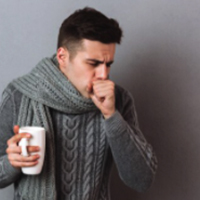Non-pharmacological remedies for post-viral acute cough

Accepted: June 13, 2021
All claims expressed in this article are solely those of the authors and do not necessarily represent those of their affiliated organizations, or those of the publisher, the editors and the reviewers. Any product that may be evaluated in this article or claim that may be made by its manufacturer is not guaranteed or endorsed by the publisher.
Authors
The post-viral acute cough (PAC) is a widespread symptom, mainly in childhood and adolescence, and is usually associated with an acute upper respiratory infection, namely the common cold. The use of cough relievers is, therefore, impressive, as documented by the market data. There are many medical devices and dietary supplements for treating PAC, which contain non-pharmacological components. Ancient people used traditional herbs to treat PAC. Thus, a well-established tradition considers natural remedies as an effective and safe way to relieve PAC. The herbal agents include polyphenols, flavonoids, saponins, glucosides, and alkaloids. Also, the European Medicine Agency has recognized the value of plant extracts and other natural substances to treat PAC. Nevertheless, a few studies investigated the role of non-pharmacologic remedies for PAC. There is some evidence for honey, glycerol, Althea officinalis, Drosera rotundifolia, Grindelia, Hedera helix, Pelargonium sidoides, Sambucus nigra, Thymus vulgaris, hyaluronic acid, and saline solutions. However, further rigorous studies should confirm natural products' efficacy and safety to relieve PAC.
How to Cite

This work is licensed under a Creative Commons Attribution-NonCommercial 4.0 International License.
PAGEPress has chosen to apply the Creative Commons Attribution NonCommercial 4.0 International License (CC BY-NC 4.0) to all manuscripts to be published.
Similar Articles
- Shyam Kanhaiya Saroj, Tushti Bhardwaj, Non-pharmacological interventions for tobacco cessation: A systematic review of existing practices and their effectiveness , Monaldi Archives for Chest Disease: Vol. 92 No. 4 (2022)
- Vidushi Rathi, Pranav Ish, Comments on “Clinical, radiological and histopathological profile of patients with endobronchial lesions on fibreoptic bronchoscopy” by Sarma et al. , Monaldi Archives for Chest Disease: Vol. 93 No. 4 (2023)
- Francesca Gatta, Yama Haqzad, George Gradinariu, Pietro Giorgio Malvindi, Zubair Khalid, Rona L. Suelo-Calanao, Nader Moawad, Aladdin Bashir, Luke J. Rogers, Clinton Lloyd, Bao Nguyen, Karen Booth, Lu Wang, Nawwar Al-Attar, Neil McDowall, Stuart Watkins, Rana Sayeed, Saleh Baghdadi, Andrea D’Alessio, Maria Monteagudo-vela, Jasmina Djordjevic, Matej Goricar, Solveig Hoppe, Charlotte Bocking, Azar Hussain, Betsy Evans, Salman Arif, Christopher Malkin, Mark Field, Kully Sandhu, Amer Harky, Ahmed Torky, Mauin Uddin, Muhammad Abdulhakeem, Ayman Kenawy, John Massey, Neil Cartwright, Nathan Tyson, Niki Nicou, Kamran Baig, Mark Jones, Firas Aljanadi, Colum G. Owens, Tunde Oyebanji, Joseph Doyle, Mark S. Spence, Paul F. Brennan, Ganesh Manoharan, Taha Ramadan, Sunil Ohri, Mahmoud Loubani, Redo aortic valve replacement versus valve-in-valve trans-catheter aortic valve implantation: a UK propensity-matched analysis , Monaldi Archives for Chest Disease: Vol. 94 No. 1 (2024)
- Murali Mupparapu, Rajesh Venkataram, Nandakishore Baikunje, Ivor D’Sa, Chandramouli Mandya Thimmaiah, Assessment of left ventricular function in subjects with chronic obstructive pulmonary disease , Monaldi Archives for Chest Disease: Vol. 94 No. 4 (2024)
- Paola Pierucci, Lucrezia De Michele, Maria Luisa de Candia, Federica Barratta, Cesare Gregoretti, Giovanna Elisiana Carpagnano, Giovanni Misseri, SARS-CoV-2 pneumonia and Eisenmenger’s syndrome: doubling the challenge , Monaldi Archives for Chest Disease: Vol. 94 No. 4 (2024)
- Ana Filipa Amador, Catarina Martins da Costa, João da Silva Santos, Cláudia Camila Dias, Elisabete Martins, First-degree atrioventricular block in hypertrophic cardiomyopathy patients: an easy and worthy prognostic marker? , Monaldi Archives for Chest Disease: Early Access
You may also start an advanced similarity search for this article.

 https://doi.org/10.4081/monaldi.2021.1821
https://doi.org/10.4081/monaldi.2021.1821




